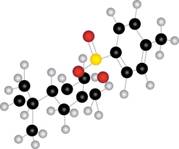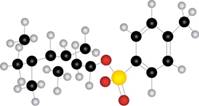
Concept explainers
In addition to organic halides, alkyl tosylates (
a.  b.
b. 
Want to see the full answer?
Check out a sample textbook solution
Chapter 26 Solutions
Organic Chemistry
- Consider diastereomers X and Y shown below. Cl diastereomer X Cl HO H OH H Each diastereomer, if treated with sodium ethoxide (NaOCH2CH3), undergoes an E2 reaction. One of the diastereomers undergoes an E2 to make a single compound. The other diastereomers undergoes E2 eliminations leading to two different compounds. Draw the mechanisms for all three of these E2 reactions, being sure to use conformational structures for the substrate in each reaction. Which of the two diastereomers will undergo an E2 reaction at the faster rate? Why? (In organic chemistry it is often said one picture is worth a thousand words. Be sure to include a picture that supports whatever argument you are making.arrow_forwardGiven that an E2 reaction proceeds with anti periplanar stereochemistry, draw the products of each elimination. The alkyl halides in (a) and (b) are diastereomers of each other. How are the products of these two reactions related? Recall from Section 3.2A that C6H5 −is a phenyl group, a benzene ring bonded to another group.arrow_forwardGiven that an E2 reaction proceeds with anti periplanar stereochemistry, draw the products of each elimination. The alkyl halides in (a) and (b) are diastereomers of each other. How are the products of these two reactions related? Recall from Section 3.2A that C6H5– is a phenyl group, a benzene ring bonded to another group.arrow_forward
- In addition to organic halides, alkyl tosylates react with organocuprates (R2CuLi) to form coupling products R–R′. When 2° alkyl tosylates are used as starting materials (R2CHOTs), inversion of the configuration at a stereogenic center results. Keeping this in mind, draw the product formed when each compound is treated with (CH3)2CuLi.arrow_forwardThe bicyclic heterocycles quinoline and indole undergo electrophilic aromatic substitution to give the products shown. (a) Explain why electrophilic substitution occurs on the ring without the N atom for quinoline, but occurs on the ring with the N atom in indole. (b) Explain why electrophilic substitution occurs more readily at C8 than C7 in quinoline. (c) Explain whyelectrophilic substitution occurs more readily at C3 rather than C2 of indole.arrow_forwardIf dehydration of 2-methylcyclohexanol were to occur under an E2 mechanism, draw the chair conformations of 2-methylcyclohexanol that would be necessary for the reaction to occur. 2-methylcyclohexanol is sold as a mixture of cis and trans isomersarrow_forward
- Rank the species in each group in order of increasing nucleophilicity. a. CH3CH2S−CH3CH2O−, CH3CO2− in CH3OH b. CH3NH2, CH3SH, CHOH in acetone c.−OH, F−, Cl− in acetone d. HS−, F−, Cl− in CH3OHarrow_forwardThe stereochemistry of the products of reduction depends on the reagent used, as you learned in Sections 20.5 and 20.6. With this in mind, how would you convert 3,3-dimethylbutan-2-one [CH3COC(CH3)3] to: (a) racemic 3,3-dimethylbutan-2- ol [CH3CH(OH)C(CH3)3]; (b) only (R)-3,3-dimethylbutan-2-ol; (c) only (S)-3,3-dimethylbutan-2-ol?arrow_forwardThe reaction of tert-butyl cyclopentyl ether with trifluoroacetic acid is shown below. Explain what kind of reaction this is (SN1, SN2, E1, E2...) and show the mechanism for this transformation.arrow_forward
- The poison gelsemoxonine can be isolated from the leaves of a plant native to southeastern Asia (Gelsemium elegans). A key step in a synthesis of this natural product involves a thermally initiated (70°C) sigmatropic rearrangement of the compound shown below (R=protecting group) (J. Am. Chem. Soc. 2011, 133, 17634–17637). Draw the curved arrows for the mechanism of the formation of gelsemoxonine. Include lone pairs in your answer.arrow_forwardQ4 Which statement below about Sn1 reactions is incorrect? (A) SN1 reactions are stepwise and have intermediates. (B) The slow step in a SN1 reaction is formation of the carbocation intermediate. (C) SN1 reactions have first order kinetics which means only the alkyl halide is involved in the rate limiting step. (D) The products of a SN1 reaction will be a pair of enantiomers. (E) An aprotic solvent is best for Sn1 reactions as they tend to help stabilize carbocation intermediates.arrow_forwardPrimary and secondary alcohols can be converted to alkyl chlorides via treatment with thionyl chloride. The reaction proceeds via an SN2 mechanism with inversion of configuration at the chiral carbon.Draw curved arrows to show the movement of electrons in this step of the mechanism.arrow_forward
 Organic ChemistryChemistryISBN:9781305580350Author:William H. Brown, Brent L. Iverson, Eric Anslyn, Christopher S. FootePublisher:Cengage Learning
Organic ChemistryChemistryISBN:9781305580350Author:William H. Brown, Brent L. Iverson, Eric Anslyn, Christopher S. FootePublisher:Cengage Learning
 Organic Chemistry: A Guided InquiryChemistryISBN:9780618974122Author:Andrei StraumanisPublisher:Cengage Learning
Organic Chemistry: A Guided InquiryChemistryISBN:9780618974122Author:Andrei StraumanisPublisher:Cengage Learning


